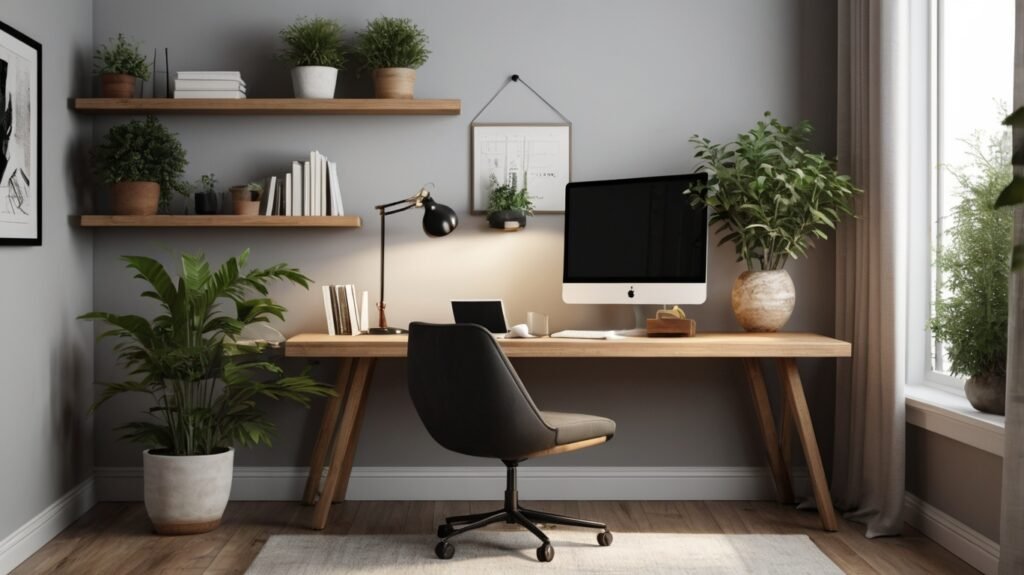The Ultimate Guide to Designing and Optimizing a Home Office
Introduction
- The increasing importance of home offices in today’s remote work environment.
- Why a well-designed workspace can improve productivity, creativity, and mental health.
- Overview of what the guide will cover: design, organization, furniture, tech tools, and tips for an ideal work-from-home setup.
Benefits of Having a Dedicated Home Office
- Improved Productivity: A distraction-free environment tailored for focus.
- Work-Life Balance: Separating personal and professional spaces within your home.
- Cost Savings: Reducing expenses like commuting, office rentals, and eating out.
- Comfort and Customization: Designing a space to suit your personal preferences and needs.
- Health and Wellness: Ergonomic furniture and natural lighting for long-term health benefits.
Key Considerations Before Designing a Home Office
- Available space: Converting a spare room, corner, or unused area.
- Your work requirements: Tech needs, paperwork, and storage.
- Comfort and ergonomics: Furniture, lighting, and airflow.
- Aesthetics and mood: Creating a space that inspires focus and creativity.
- Budget considerations: Affordable vs. high-end office designs.
Home Office Layout Ideas for Different Spaces
1. Dedicated Home Office Room
- Ideal for professionals who need privacy.
- Incorporating a desk, ergonomic chair, storage cabinets, and decor.
2. Home Office in a Small Space
- Using corners, alcoves, or under-the-stairs spaces efficiently.
- Space-saving furniture: wall-mounted desks, foldable tables, and floating shelves.
3. Dual-Purpose Home Office Spaces
- Combining the office with guest rooms, living rooms, or dining areas.
- Clever partitions, screens, and multifunctional furniture.
Essential Home Office Furniture
1. Desk
- Choosing the right desk size and shape (L-shaped, standing desks, compact desks).
- Benefits of height-adjustable desks for flexibility.
2. Ergonomic Chair
- Importance of posture and back support for long hours.
- Features to look for: lumbar support, armrests, adjustability, and comfort.
3. Storage Solutions
- Filing cabinets for paperwork and documents.
- Floating shelves, cubbies, and under-desk drawers.
4. Workstation Accessories
- Laptop stands, monitor risers, and keyboard trays.
- Cable management systems for a clean look.
Technology for a Smart and Efficient Home Office
1. Essential Tech Tools
- Computers, laptops, and dual-monitor setups for multitasking.
- High-speed internet for seamless connectivity.
- Noise-canceling headphones for focus and calls.
2. Productivity Software
- Tools for project management: Trello, Asana, or Monday.com.
- Video conferencing platforms: Zoom, Microsoft Teams, or Google Meet.
- Note-taking apps like Evernote or Notion for organization.
3. Lighting Solutions
- Importance of natural lighting for productivity and mood.
- LED desk lamps and task lighting to reduce eye strain.
Organizing Your Home Office for Maximum Efficiency
- Decluttering: Minimizing unnecessary items to maintain focus.
- Labeling and categorizing files, cords, and supplies.
- Digital organization: Cloud storage and paperless workflows.
- Minimalist designs to reduce distractions.
Home Office Decor: Balancing Functionality and Style
- Choosing a color palette for focus: neutral tones, pastels, or energizing colors.
- Adding personal touches like artwork, plants, and decorative shelves.
- Stylish but functional office supplies: organizers, holders, and pens.
Ergonomics and Health Tips for Home Office Workers
- Setting up your desk and chair for proper posture.
- Importance of standing desks or breaks to reduce sitting time.
- Blue light glasses and screen filters to protect eyes.
- Incorporating plants for improved air quality and ambiance.
Creating a Distraction-Free Environment
- Tips for working in shared or noisy homes.
- Using noise-canceling headphones and white noise machines.
- Creating boundaries with family members during work hours.
- Tools to limit distractions: website blockers, timers, and focus techniques.
Budget-Friendly Home Office Solutions
- Affordable furniture options: DIY desks, repurposing tables, or thrift store finds.
- Using second-hand tech or upgrading gradually.
- Creative storage ideas using household items.
Sustainable and Eco-Friendly Home Office Design
- Using reclaimed or sustainable materials for furniture.
- Reducing paper usage with digital tools.
- Adding energy-efficient lighting and smart power strips.
- Choosing eco-friendly accessories like bamboo organizers.
Conclusion
- Recap of the importance of a functional, comfortable, and inspiring home office.
- Encouragement to tailor the space to your specific work style and needs.
- Final tips for maintaining your home office space for long-term success.
Gallery of Home Office Closets






